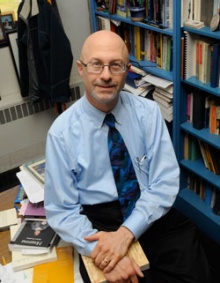Blind Date With a Jewish Book: Second Edition With a Yizkor Book?

Dr. Theodore Steinberg, retired distinguished professor emeritus of the faculty of English at SUNY Fredonia
Blind Date – with a Yizkor Book?
Byline: Cecile E. Minkoff
Our second blind date with a Jewish book took place in March. This time, the presentation was by Dr. Theodore Steinberg, distinguished professor emeritus of the faculty of English at SUNY Fredonia, and, since his retirement, a beloved teacher in the local community.
Yizkor Books, or Memory Books, represent a unique genre of Jewish literature that blossomed in the wake of the Shoah in an attempt to memorialize the communities that were wiped out: their members, their institutions, their newspapers, clubs, and associations, along with vivid firsthand accounts of the Shoah and its aftermath. These are not to be confused with the “Yizkor Books” that we use on the days when yahrzeit is observed in synagogues.
Steinberg’s interest in Yiddish began early in his career when he published a book about S.Y. Abramovitsh, more popularly known as Mendele Mokher Seforim, or, Mendele the Book Peddlar. More recently, as the idea of “world literature” took hold, and noticing that modern Yiddish literature was rarely, if ever, included in the new anthologies, he started to argue for the inclusion in them of the modern Yiddish novelists and poets. Certainly, if the world didn’t know Yiddish literature, all of the great Yiddish writers knew world literature. Like the Jew in the world, Yiddish literature was the orphan child of world literature. But, after he retired from SUNY Fredonia, he found himself teaching a beginner’s class in reading Yiddish. Toward the end of the course, a student approached him saying, “I have a Yiddish book I’d like you to look at.” It was a yizkor book from his grandmother’s town in Poland, and he asked Steinberg if he would translate it. And so Ted Steinberg found himself immersed in the universse of yizkor books.
During the Shoah, hundreds of communities were wiped out,. But afterwards, survivors of these communities re-established contact with each other across the globe, called upon one another to write chapters, and collected them into books. Each book is a memorial to its community, like a tombstone for all the people for whom no tombstone was ever made.
This was a completely voluntary exercise, and Steinberg emphasized that the contributors were not professional writers, and so they often used flowery language in order to sound more sophisticated. The view through these post-Shoah lenses is almost always rosy and nostalgic. Steinberg noticed that negative commentary is rare, except perhaps about a teacher or a school. Nevertheless, you get the sense of real cities and towns, real people, and as you read, you gain perspective from multiple points of view, and begin to know individuals and to identify with them. These books describe a vibrant life, and certain topics are regular, beginning with a history of the town, including short vignettes of important, or even famous, people, or of outstanding personalities, and continuing with sections on schools, libraries, poltical and social clubs, athletic organizations, synagogues, and study houses. Football (i.e. soccer) was popular, and you find accounts of matches played between the Jewish club and a gentile team from nearby; sometimes these games were rough, sometimes clean.
Very often memories will take the reader back to World War I. In our generation, our lives are so deeply branded by the Second World War, that we give little attention to the first, which was as deeply traumatizing and disruptive in its own way as the second.
Descriptions of life during the Shoah and its aftermath were written by Jews who were hidden, or who passed as gentiles. They were also stitched together from letters in the possession of Jews who had been able to flee, and who had received letters with “news from home,” until the letters stopped. These descriptions, Steinberg said, are devastating to read, and the work of translation slows, as one can only absorb so much at one time.
Because these are first-hand recollections written by the people who were themselves involved in the lives of their communities, these books represent a valuable primary resource for historical study akin to the Cairo Geniza for offering up details of daily life.
Because these books represented private endeavors and were often privately printed, they can be hard to track down. There are approximately 1,200 yizkor books currently extant. The New York Public Library and the National Yiddish Book Center have digitized them and made them available online for free. The Jewish Genealogical Society has committed itself to overseeing their translations into English, a work in progress.
Steinberg finished his presentation by commenting on the moral responsiblity to do the work so that they are accessible to future generations. Seven decades after the Nazi murderers were defeated, it is still so hard to grasp the full impact of the Shoah. These books, with their vivid descriptions of life before, and their stark lists of the names of the departed, go some way to bridge the gap.
Online resources for yizkor books are:
The National Yiddish Book Center Yizkor Book Collection: https://www.yiddishbookcenter.org/collections/yizkor-books
New York Public Library Yizkor Book Collection: https://digitalcollections.nypl.org/collections/yizkor-book-collection#/?tab=about
Jewish Geneaological Society https://www.jewishgen.org/yizkor/